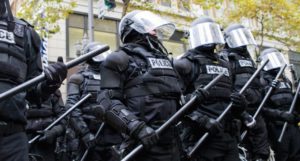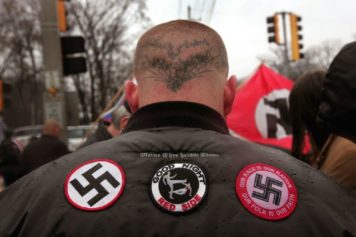
Despite the known threat of white supremacist infiltration in law enforcement, only the FBI has taken notice, as the problem of white domestic terror is ignored in favor of a focus on Islamic extremism. (Photo: Pinterest)
White Supremacists Infiltrate Law Enforcement with only the FBI Tracking the Threat
Imagine a country where the white supremacists don’t have to hide, cover their faces, go underground or run from the law, but rather become the law and facilitate their crimes of terror against Black people. Welcome to the United States of America.
White supremacist groups, neo-Nazis, Ku Klux Klan and other domestic terror groups have been infiltrating law enforcement agencies and police departments throughout America. In January 2017, The Intercept had initially reported both on a classified FBI Counterterrorism Policy Guide from 2015 noting that “domestic terrorism investigations focused on militia extremists, white supremacist extremists, and sovereign citizen extremists often have identified active links to law enforcement officers,” and a redacted 2006 intelligence report from the FBI entitled, “White Supremacist Infiltration of Law Enforcement.” This is evidence showing that the federal bureau has been actively investigating the problem.
The 2006 FBI report sounds the alarm on the growing threat of white supremacist police and the risk they pose to society, even to the police themselves. “The primary threat from infiltration or recruitment arises from the areas of intelligence collection and exploitation, which can lead to investigative breaches and can jeopardize the safety of law enforcement sources and personnel,” the report said. “White supremacist presence among law enforcement personnel is a concern due to the access they may possess to restricted areas vulnerable to sabotage and to elected officials or protected persons, whom they could see as potential targets for violence.”
According to the FBI, intelligence that one extremist group obtains through law enforcement infiltration can benefit other groups because of the multiple allegiances white supremacists tend to have. Further, with 18,000 independent law enforcement agencies with no common recruitment policy, and many having deep and troubling racist ties, this presents a field day for white supremacist groups.

Local law enforcement officers were acting with virtual impunity from state prosecution as they participated in the murders of civil rights workers Andrew Goodman, James Chaney, and Michael Schwerner near Philadelphia, Mississippi, in 1964. Photo: FBI
The report alludes to the historical role of white supremacists infiltrating and recruiting in law enforcement, a point which is worth expounding on. For example, during the Jim Crow era, the membership of the Ku Klux Klan and the local police departments in the South overlapped, if they were not one and the same. Law enforcement was involved in the arrest, abduction and murder of three civil rights workers — Andrew Goodman, James Chaney and Michael Schwerner — in Philadelphia, Mississippi, in 1964, at a time of impressive growth in Klan. An FBI investigation revealed the Philadelphia Police Department, the White Knights of the KKK and the Neshoba County Sheriff’s Office participated in the murders.
More recently, the evidence of white domestic terrorists on the force is clear and cannot be ignored. For example, two officers in Williamson County, Texas, were fired due to their membership in the KKK. Police in Cleveland have a history of Nazi and white power ties and scrawling racist graffiti throughout their department. In Los Angeles, a white supremacist gang known as the Vikings was founded by Los Angeles County Sheriff’s deputies, engaging in and motivated by “racial hostility” and “terrorist-type tactics” with the knowledge of their superiors, according to a federal court.
Chicago police commander Jon Burge, a man with reported KKK membership in Indiana, tortured 100 Black men from the 1970s to the early 1990s. Josh Doggrell, a police lieutenant in Anniston, Alabama, lost his job after speaking at the annual gathering of the League of the South — a neo-Confederate organization advocating for secession and a white-dominated nation — and displaying a “not equal” sign on his Facebook page. A police chief in an Oklahoma town recently resigned after his name was connected to a white supremacist website, and in 2014 a deputy police chief and an officer in Florida were fired from their department after the FBI outed their KKK membership.
In Philadelphia, Pennsylvania, police officer Hans Lichterman drew attention for wearing a Nazi tattoo on his arm. An internal affairs investigation determined the officer did not violate department policy.
One term that is relevant to the discussion of police infiltration is “ghost skins”— in which white supremacist groups change their behavior and looks and “avoid overt displays of their beliefs to blend into society and covertly advance white supremacist causes.” The FBI report claims at least one white supremacist group has encouraged infiltration in the police to alert the organization if law enforcement is investigating it.
In a recent episode of CBS’ “60 Minutes,” Christian Picciolini, a reformed skinhead, explained. “You know 30 years ago we were skinheads. We wore swastikas and shaved heads, and you could identify us pretty easily,” he said. “So we decided at that time to grow our hair out, to trade in our boots for suits and we encouraged people to get jobs in law enforcement, to go to the military and get training and to recruit there.”
In a country in which 74 percent of extremist killings over the past decade were the work of right-wing extremists — particularly white supremacists, not Islamic terrorists — we have a problem when the police are among the terrorists, and the Nazi protesters have traded in their costumes for button-down shirts and khakis. Further, all of this provides context to the longstanding scourge of racist police violence against Black people — often downplayed if not denied by segments of society and an administration that was endorsed by the Fraternal Order of Police. While the FBI is alone in investigating the infiltration of law enforcement by these hate groups — who have a history of killing Black people and police officers — President Trump and his Attorney General Jeff Sessions have shown deference to law enforcement and retreated from federal oversight of police departments with a history of civil rights violations, brutality and racial violence.
In 2009, the Department of Homeland Security also sounded the alarm on the rise of white supremacist and affiliated groups with a report called “Rightwing Extremism: Current Economic and Political Climate Fueling Resurgence in Radicalization and Recruitment.” According to the report, “The economic downturn and the election of the first African American president present unique drivers for rightwing radicalization and recruitment,” with right-wing extremists focusing on “the economy, the perceived loss of U.S. jobs in the manufacturing and construction sectors, and home foreclosures,” as well as “immigration and citizenship, the expansion of social programs to minorities, and restrictions on firearms ownership and use.” The DHS report caused a backlash among conservative lawmakers, causing the department to dissolve the team that wrote the report and curtail its intelligence and analysis of homegrown domestic extremism unrelated to Muslims. Fast forward to the Trump administration, which has sought cuts to domestic counterterror programs that target white supremacist groups such as the “very fine people” who marched in the violent August 2017 “Unite the Right” neo-Confederate rally in Charlottesville, Virginia, that left one counterprotester dead and 19 injured. The program known as “Countering Violent Extremism” — which has stigmatized American Muslims and amounted to spying on law-abiding citizens, according to civil liberties groups — would be changed to “Countering Islamic Extremism” or “Countering Radical Islamic Extremism,” giving white terror groups a pass.
According to the FBI, the First Amendment protects one’s membership in the Klan or some other white supremacist group for lawful activity. However, the government can limit the job opportunities of such groups in law enforcement and other sensitive public-sector positions when their membership would interfere with their duties. The question is whether the country possesses the will to stem the tide of neo-Nazis and the KKK in law enforcement and root them out wherever they are.


